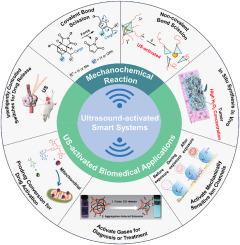Ultrasound-activated mechanochemical reactions for controllable biomedical applications
Q1 Engineering
引用次数: 0
Abstract
Intramolecular bonds in small organic molecules, macromolecules, and organic-inorganic hybrids are broken or formed by ultrasound-activated mechanical force that can be applied with spatial and temporal precision for contactless external control of mechanochemical reactions. Ultrasound featuring non-invasiveness, high tissue penetration, and spatiotemporal controllability has shown great potential in controlling the activation of mechanochemical reactions such as chemical bond scission, natural enzyme activation, and catalytic radical generation for targeted drug or gene therapy. Here, we comprehensively summarize the latest research and future trends in ultrasound-activated mechanochemical reactions for smart biomedical applications. First, the mechanism of ultrasound-activated mechanochemical reactions will be outlined. Then, the types of mechanochemical reactions will be carefully discussed. After that, the representative biomedical applications have been summarized from a unique perspective. Finally, we systematically emphasize the current challenges and future outlooks to guide the rational design of ultrasound-activated drug release over conventional drug-loaded therapies. We believe that this review will substantially facilitate the progression and widespread utilization of ultrasound-activated mechanochemical reactions in biomedical applications.

用于可控生物医学应用的超声激活机械化学反应
小有机分子、大分子和有机-无机杂化物中的分子内键可通过超声波激活的机械力来断裂或形成,这种机械力可以在空间和时间上精确应用,从而实现对机械化学反应的非接触式外部控制。超声波具有非侵入性、高组织穿透性和时空可控性等特点,在控制化学键断裂、天然酶活化和催化自由基生成等机械化学反应的活化方面显示出巨大的潜力,可用于靶向药物或基因治疗。在此,我们全面总结了超声激活机械化学反应在智能生物医学应用方面的最新研究和未来趋势。首先,我们将概述超声激活机械化学反应的机理。然后,将仔细讨论机械化学反应的类型。然后,从独特的角度总结了具有代表性的生物医学应用。最后,我们系统地强调了当前的挑战和未来的展望,以指导合理设计超声激活药物释放而非传统药物负载疗法。我们相信,这篇综述将极大地推动超声激活机械化学反应在生物医学应用中的发展和广泛应用。
本文章由计算机程序翻译,如有差异,请以英文原文为准。
求助全文
约1分钟内获得全文
求助全文
来源期刊

Smart Materials in Medicine
Engineering-Biomedical Engineering
CiteScore
14.00
自引率
0.00%
发文量
41
审稿时长
48 days
 求助内容:
求助内容: 应助结果提醒方式:
应助结果提醒方式:


